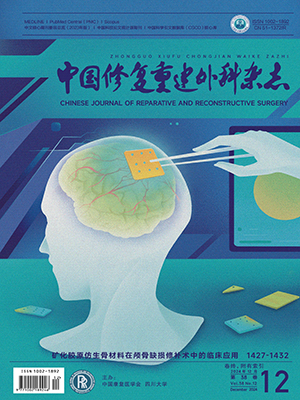| 1. |
Pache S, Aman ZS, Kennedy M, Nakama GY, et al. Posterior cruciate ligament: Current concepts review. Arch Bone Jt Surg, 2018, 6(1): 8-18.
|
| 2. |
Jung YB, Jung HJ, Song KS, et al. Remnant posterior cruciate ligament-augmenting stent procedure for injuries in the acute or subacute stage. Arthroscopy, 2010, 26(2): 223-229.
|
| 3. |
Razi M, Ghaffari S, Askari A, et al. An evaluation of posterior cruciate ligament reconstruction surgery. BMC Musculoskelet Disord, 2020, 21(1): 526. doi: 10.1186/s12891-020-03533-6.
|
| 4. |
Lee YS, Jung YB. Posterior cruciate ligament: focus on conflicting issues. Clin Orthop Surg, 2013, 5(4): 256-262.
|
| 5. |
Seo YJ, Song SY, Kim IS, et al. Graft tension of the posterior cruciate ligament using a finite element model. Knee Surg Sports Traumatol Arthrosc, 2014, 22(9): 2057-2063.
|
| 6. |
Kennedy NI, LaPrade RF, Goldsmith MT, et al. Posterior cruciate ligament graft fixation angles, part 1: biomechanical evaluation for anatomic single-bundle reconstruction. Am J Sports Med, 2014, 42(10): 2338-2345.
|
| 7. |
Markolf KL, Feeley BT, Jackson SR, et al. Where should the femoral tunnel of a posterior cruciate ligament reconstruction be placed to best restore anteroposterior laxity and ligament forces? Am J Sports Med, 2006, 34(4): 604-611.
|
| 8. |
Apsingi S, Bull AM, Deehan DJ, et al. Review: femoral tunnel placement for PCL reconstruction in relation to the PCL fibre bundle attachments. Knee Surg Sports Traumatol Arthrosc, 2009, 17(6): 652-659.
|
| 9. |
Chung K, Choi CH, Kim SH, et al. The relationship between lateral femoral anatomic structures and the femoral tunnel outlet in anterior cruciate ligament reconstruction using the transportal technique: A 3-dimensional simulation analysis. Orthop J Sports Med, 2020, 8(9): 2325967120952783. doi: 10.1177/2325967120952783.
|
| 10. |
Shea KG, Cannamela PC, Fabricant PD, et al. All-epiphyseal anterior cruciate ligament femoral tunnel drilling: Avoiding injury to the physis, lateral collateral ligament, anterolateral ligament, and popliteus-a 3-dimensional computed tomography study. Arthroscopy, 2018, 34(5): 1570-1578.
|
| 11. |
Alentorn-Geli E, Stuart JJ, James Choi JH, et al. Posterolateral portal tibial tunnel drilling for posterior cruciate ligament reconstruction: technique and evaluation of safety and tunnel position. Knee Surg Sports Traumatol Arthrosc, 2017, 25(8): 2474-2480.
|
| 12. |
Chia SL, Kapoor V, Ali MM, et al. The posterior cruciate ligament: an anthropometric study in Asians and evaluation of safe limits for bony tunnel creation during reconstruction. Ann Acad Med Singap, 2002, 31(5): 631-635.
|
| 13. |
Athwal KK, Willinger L, Shinohara S, et al. The bone attachments of the medial collateral and posterior oblique ligaments are defined anatomically and radiographically. Knee Surg Sports Traumatol Arthrosc, 2020, 28(12): 3709-3719.
|
| 14. |
LaPrade RF, Engebretsen AH, Ly TV, et al. The anatomy of the medial part of the knee. J Bone Joint Surg (Am), 2007, 89(9): 2000-2010.
|
| 15. |
Tompkins M, Keller TC, Milewski MD, et al. Anatomic femoral tunnels in posterior cruciate ligament reconstruction: inside-out versus outside-in drilling. Am J Sports Med, 2013, 41(1): 43-50.
|
| 16. |
Warren LF, Marshall JL. The supporting structures and layers on the medial side of the knee: an anatomical analysis. J Bone Joint Surg (Am), 1979, 61(1): 56-62.
|
| 17. |
Hughston JC, Eilers AF. The role of the posterior oblique ligament in repairs of acute medial (collateral) ligament tears of the knee. J Bone Joint Surg (Am), 1973, 55(5): 923-940.
|
| 18. |
Kim JH, Kim HY, Lee DH. Location of the femoral tunnel aperture during single-bundle posterior cruciate ligament reconstruction: outside-in versus inside-out techniques. Int Orthop, 2018, 42(9): 2097-2103.
|
| 19. |
Yi A, Kleiner MT, Lorenzana D, et al. Optimal femoral tunnel positioning in posterior cruciate ligament reconstruction using outside-in drilling. Arthroscopy, 2015, 31(5): 850-858.
|
| 20. |
Jette C, Pomés J, Sastre S, et al. Safe drilling angles avoid femoral tunnel complications during combined anterolateral ligament and anterior cruciate ligament reconstruction. Knee Surg Sports Traumatol Arthrosc, 2019, 27(11): 3411-3417.
|
| 21. |
Zhu M, Han Lee DY, Williams A. Safe femoral fixation depth and orientation for lateral extra-articular tenodesis in anterior cruciate ligament reconstruction. Orthop J Sports Med, 2021, 9(1): 2325967120976591. doi: 10.1177/2325967120976591.
|
| 22. |
Yoshino N, Takai S, Ohtsuki Y, et al. Computed tomography measurement of the surgical and clinical transepicondylar axis of the distal femur in osteoarthritic knees. J Arthroplasty, 2001, 16(4): 493-497.
|
| 23. |
Chen CH, Chen WJ, Shih CH. Arthroscopic reconstruction of the posterior cruciate ligament: a comparison of quadriceps tendon autograft and quadruple hamstring tendon graft. Arthroscopy, 2002, 18(6): 603-612.
|
| 24. |
Reddy AS, Frederick RW. Evaluation of the intraosseous and extraosseous blood supply to the distal femoral condyles. Am J Sports Med, 1998, 26(3): 415-419.
|
| 25. |
Gancel E, Magnussen RA, Lustig S, et al. Tunnel position following posterior cruciate ligament reconstruction: an in vivo computed tomography analysis. Knee, 2012, 19(4): 450-454.
|
| 26. |
Li G, DeFrate L, Suggs J, et al. Determination of optimal graft lengths for posterior cruciate ligament reconstruction-a theoretical analysis. J Biomech Eng, 2003, 125(2): 295-299.
|
| 27. |
Handy MH, Blessey PB, Kline AJ, et al. The graft/tunnel angles in posterior cruciate ligament reconstruction: a cadaveric comparison of two techniques for femoral tunnel placement. Arthroscopy, 2005, 21(6): 711-714.
|




